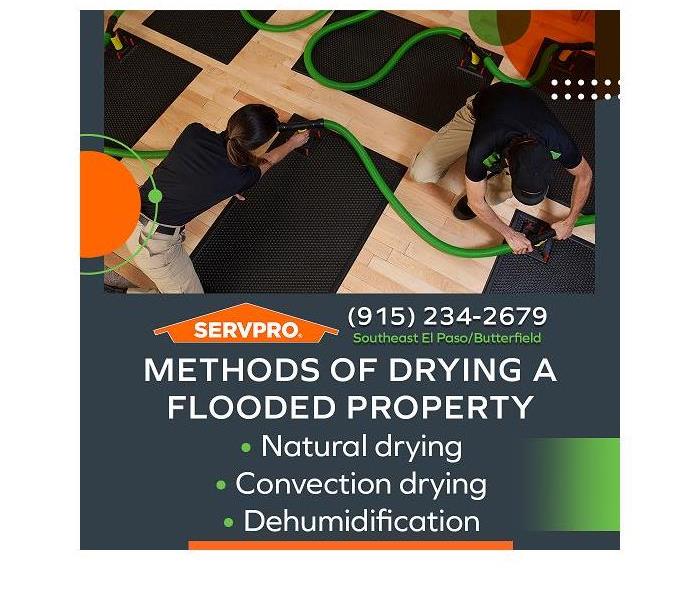SERVPRO of Southeast El Paso/Butterfield outlines the various ways to dry a flooded house
9/16/2022 (Permalink)
Blog Summary: Is your property flooded? Here are the different ways you can dry it.
Several factors can lead to flooding in your home or business. It could be a result of excessive rainfall, blocked drainage, pipe leaks, appliance malfunctions, or sewage backup. Regardless of what led to the flood, what matters most is the action you take after that to reduce the damage.
After the water has been removed from your home, the next step is to dry out the house and any affected belongings properly. This is often best left to professional flood restoration services, as they have the tools and experience to do the job perfectly.
SERVPRO® of Southeast El Paso/Butterfield, a local leader in the East El Paso, TX home water damage restoration landscape, has explained the various methods of drying a flooded property.
1. Natural drying
This is the slow natural ventilation method that involves using the sun, fans, and other natural sources to dry up a flooded property. You can’t control the temperature, airflow, and humidity when drying with this method, and it may be difficult for the air to permeate some rooms in the building that don’t have access to ventilation. You’ll typically just need to open the property for proper ventilation.
The material of the structures, the level that the water has permeated the property structures and belongings, the humidity of the air around it, and the temperature will all affect how quickly the material dries. The benefit of natural drying is that it costs nothing and isn’t labor-intensive.
On the other hand, natural drying is impossible when the sun is not out or the sunlight is not enough, and it takes a longer time to dry up, which can put your home at risk of developing mold.
2. Convection drying
Convection drying is a technique that combines regular air movers with high-temperature heat while leaving the windows open. This is an alternative to drying in the sun if there’s not enough sunlight in your area. It typically involves increasing the airflow around the wet structures to promote the evaporation of internal moisture.
You may need a supplementary heat source to create the necessary drying conditions and speed up the evaporation of moisture if the building's primary heating system is not working or is not sufficient.
Another option is to use heating systems to target difficult drying areas. However, heating can also pose problems, as overheating can cause more harm to the structure.
3. Dehumidification
A dehumidifier might be your best friend in any situation where moisture is an issue. Dehumidification is a technique that draws moisture from the air through condensation. Dehumidifiers function by lowering the dew point of evaporating air, which causes condensation to form on the internal coils.
Following that, the water is automatically pumped away or collected in containers. A dehumidifier can speed up the drying process of a water-damaged region by drawing in damp air, eliminating moisture, and exhaling dry air.
They function best in warm air (20°–25°C) with high relative humidity (RH) of at least 60%.
Get expert flood restoration services in East El Paso, TX.
SERVPRO of Southeast El Paso/Butterfield is the East El Paso flood restoration services team you can rely on. They specialize in flood drying and water damage restoration services and guarantee that every service will be delivered efficiently and to your satisfaction.
They have a team of trained and licensed technicians that can undertake damage of all kinds. Their cutting-edge drying equipment and technological know-how allow them to help in several situations.
Their experts will visit you once you call, evaluate the problem, and offer you their assessment and advice.
Contact SERVPRO of Southeast El Paso/Butterfield at (915) 234-2679 for a free consultation.




 24/7 Emergency Service
24/7 Emergency Service
